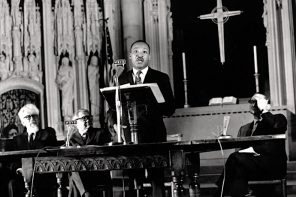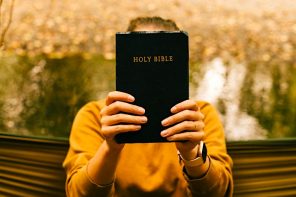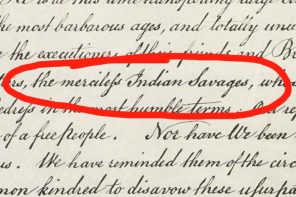In this RD10Q, Joseph Winters explores a new interpretation of hope that makes space for black melancholy and vulnerability.
What inspired you to write Hope Draped in Black?
I’ve always been intrigued by the relationship between suffering, narrative, and the social demand to “be positive.” In other words, the book is a product of my interest in how we are shaped to acknowledge tragedy, but yet also relate to it in ways that diminish its intensity. Here I’m thinking of the pressure placed on grieving selves to move on, to make loss an occasion for some future triumph—or the general compulsion to resolve and overcome the unavoidable conflicts in life.
On a personal level, I have experienced this in moments when I lost someone close to me and in moments when well-meaning people tried to make me feel reassured about death by saying someone is in a better place or everything happens for a reason. While I understand this kind of response, I learned that lingering in the extended moment of loss is sometimes inescapable even if it has ambivalent effects.
I am also intrigued by the ways this relationship between suffering and narrative works politically—especially in the context of narratives about black history and experience. The language of progress and freedom has been indispensable to black liberation struggles. It is difficult to understand the work of someone like W.E.B Du Bois without underscoring his attachment to progress and civilization.
At the same time, Du Bois suggested that the grammar of progress tends to diminish our capacity to contemplate and remember the violence that accompanies anti-blackness. Progress often allows the achievements of history to compensate for, and overcome, the losses that are always attached to any victory. In addition, progress narratives tend to deny the violence that is necessary for progress to happen. As Walter Benjamin suggests, triumphant notions of progress threaten to kill the dead twice. On the one hand, progress has justified violence in the name of spreading civilization and law to people of color. In addition progress, for Benjamin, kills the dead again through forgetfulness and erasure.

Hope Draped in Black: Race, Melancholy, and the Agony of Progress
Joseph R. Winters
Duke University Press
June 2016
Also my book is inspired by the pleasures and pains involved in reading black literature and critical theory together. While authors like Toni Morrison and Theodor Adorno may seem like strange bedfellows, I am very much invested in how these authors share a tendency to trouble traditional notions of hope. For these authors, prospects for a better world depend largely on how we remember and how we relate to loss and suffering.
Black literature and critical theory point beyond the pessimism-optimism binary that governs contemporary academic discussions. A different kind of hope is occasioned and made possible by melancholy and a recalcitrant sense of the tragic. My book suggests that black studies and critical theory provide resources for thinking about current tensions surrounding black achievement. This sense of tension has been experienced recently as the opening of the national African American museum happens amidst daily incidents of police violence against working-class black bodies.
Finally, this book was inspired by the collective excitement and optimism that gathered around Obama’s ascendancy. I was struck by how many people—inside and outside of the academy, across the political spectrum—read his 2008 victory as a collective triumph for black people, America, and the world. While this excitement has subsided to some extent, I am interested in how this instance of optimism is emblematic of long-established attachments to progress and redemption.
What’s the most important take-home message for readers?
The most important message is that progress and hope are not synonymous in the context of black literature and aesthetics. Writers like Du Bois, Ellison and Morrison, and filmmakers like Charles Burnett show us that a different kind of hope (not optimism, not progress) is opened up. This isn’t necessarily by trying to overcome the tragic but by contemplating the affinities between pleasure and anguish, intimacy and violence, the tragic and the comic, and remembrance and moving forward/backward. Similarly, readers should take home from the book a sense that melancholy and remembrance are ethical dispositions, ways of being receptive and vulnerable to temporal and spatial others.
Is there anything you had to leave out?
I lament leaving out a discussion about Black Lives Matter and recent struggles against state surveillance of, and violence against, blackness. Part of this omission has to do with the timeline and process of publishing. While the book was released in June of this year, I was finishing up some of the final edits at end of 2014 when the second Ferguson uprising was underway. While I briefly address Trayvon Martin’s death and President Obama’s response to George Zimmerman’s acquittal, more time and space would have allowed me to think seriously about BLM and how this emerging movement accords with my understanding of melancholic hope.
In addition, I left out an explicit engagement with recent discussions in black studies—particularly between the Afro-optimists (Fred Moten) and the Afro-pessimists (Frank Wilderson III). While I certainly engage and cite these authors in the book, I can imagine a different conclusion to my book that situated my project in these debates and discussions.
What are some of the biggest misconceptions about your topic?
The biggest misconception about my topic is that melancholy and hope are incompatible desires and attachments. In other words, people tend to associate melancholy with simple pessimism and despair and hope with optimism and a sense that everything is going to work out. My sense is that we can redefine hope as a desire for something better—a prospect informed and traversed by melancholy, vulnerability, and difficult forms of remembrance.
As I show in the book, sorrow songs, jazz, and blues provide resources for thinking about hope as melancholy, or melancholy as hope. As Fred Moten suggests, the image and sound of the jazz break or cut is crucial: it registers both a wound and an opening. Maintaining the tension and intimacy between the torment and the beauty of black life is what my book tries to accomplish.
Did you have a specific audience in mind when writing?
I did not necessarily have a specific audience in mind. Yet when I was writing the book, I kept thinking generally about colleagues in religious studies and black studies, and family members and friends who have encouraged me throughout the writing process and my life. So I tried my best to be clear, accessible, and free of jargon while dealing with difficult authors and concepts. I don’t know if I was successful.
Are you hoping to just inform readers? Entertain them? Piss them off?
I suppose I am trying to be provocative, to please and disturb, to inform and unsettle. While I appreciate different styles of writing, I find most appealing writing formats that refuse our desires for coherence, clarity and resolution. I intended to leave the reader with a lingering sense of tension and ambivalence in the face of black strivings, precisely because this response works against the regime of progress and its conciliatory nature.
What alternative title would you give the book?
The Audacity of Melancholy: Race, Tragedy, and the Anguish of Progress.
How do you feel about the cover?
I love the cover. Duke University Press sent me two fascinating possibilities, but the design that I selected—with the help of my partner, Kamilah Legette—best visualizes the play between the opaque and the iridescent or, as Du Bois might say, the twilight of dawn and dusk. I cannot imagine a better press to work with.
Is there a book out there you wish you had written? Which one? Why?
That would be Saidiya Hartman’s Scenes of Subjection: Terror, Slavery, and Self-Making in Nineteenth Century America. The book is brilliant in so many ways, but I especially appreciate the way that Hartman interrupts progressive narratives, or linear slavery-to-freedom accounts of black American history. Her description of how the end of slavery hurled black bodies into new configurations of power and regulation performs a critique of progress and facile notions of freedom that I can only imitate. In addition, the way she uses the notion of opacity to think about the hidden pain, and pleasure, in everyday scenes of subjection and terror is so generative.
What’s your next book?
My next book is tentatively titled Disturbing Profanity: Hip Hop, Social Death, and the Ambivalent Sacred. In this book, I use the ambivalent quality of the sacred as discussed in critical theories of religion and black studies to reimagine the complexities of hip hop culture. My hope is to contribute to the remarkable work done on hip hop and religion in recent years, especially by Anthony Pinn, Monica Miller and Ebony Utley.





